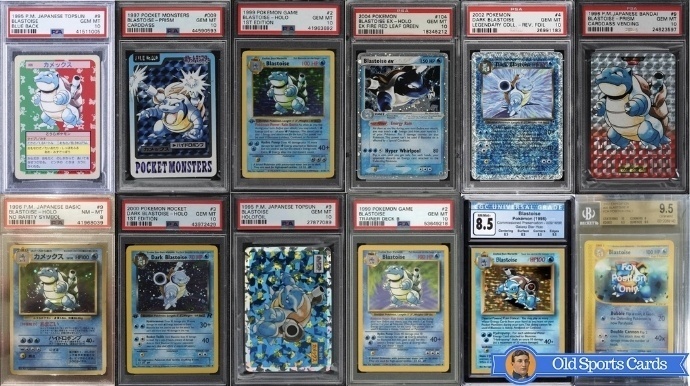
As the card-collecting world continues to heat up, demand for Blastoise Pokemon cards continues to follow suit.
After all, Blastoise is one of the most iconic characters in the entire franchise...
And much of Blastoise's popularity can be traced to its debut as the cover mascot of the original Pokémon Blue video game.
Since then, Blastoise has remained one of the coolest-looking of all Pokémon with its twin water cannons that retract from the shell on its back.
Nowadays, many of those kids who grew up with these cards are now adults with more spending power able to pay big bucks for them in top condition.
Some of them are among the most expensive Pokemon cards in the hobby.
And in this guide, we take a look at the 20 most valuable Blastoise cards.
Let's jump right in!
More...
20) 1997 Pocket Monsters Carddass
Sold in December, 2020 for $1,245
Bandai is a Japanese toy maker that produced a series of Pokemon cards in both 1996 and 1997 that they distributed via vending machines, or carddass, as they called them.
The 1997 Pocket Monsters set features 151 cards with bright, colorful images of each character utilizing a move for which it is known.
For example, on the Blastoise card, we can see the creature wielding its dual water cannons to fight off an opponent.
Blastoise is also one of the few characters (such as Charizard) in the set to be featured on a holofoil prism background instead of a pixelated, non-holofoil background.
The water cannon action sequence combined with the striking visual effects of the prism background give this card an incredible amount of eye appeal.
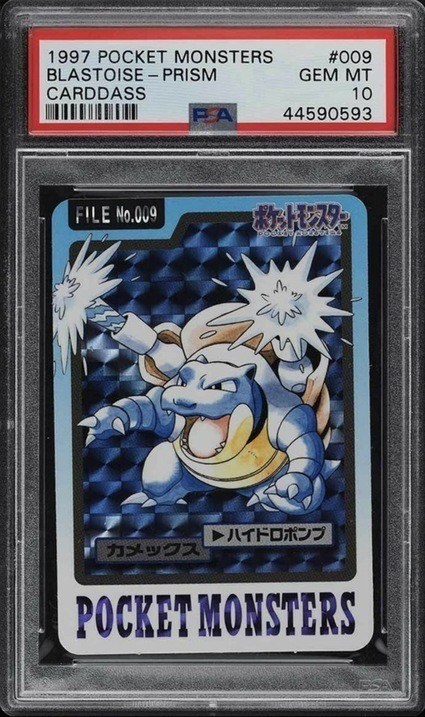
19) 1996 Pokemon Japanese Carddass Vending
Sold in January, 2021 for $1,475
And here is a look at the card that Bandai produced in 1996 for distribution in its carddass machines.
Compared to the action-packed image on their follow-up card in 1997, this one is a bit toned down, but the prism effect still gives it plenty of pop.
You'll also notice that the image of Blastoise is the same as that which was used on the base sets released in Japan in 1996 and North America in 1999.
Interestingly, because Bandai produced these cards in September 1996, they pre-dated the official launch of the Pokemon Trading Card Game that followed in October 1996.
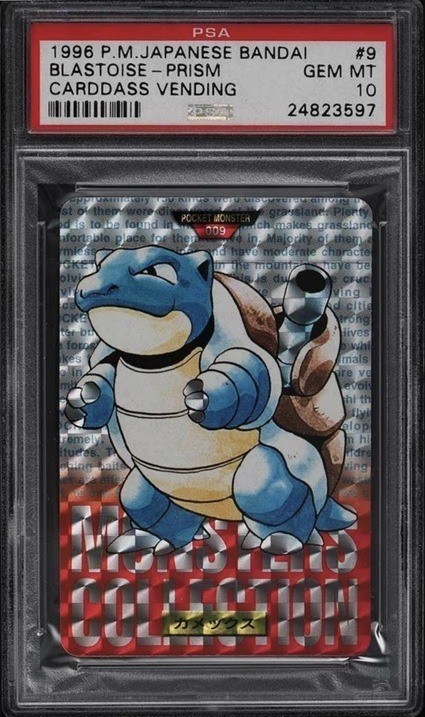
18) 2000 Pokemon Chinese First Edition
Sold in July, 2020 for $1,913
While the original base set debuted in 1999 in various countries throughout the Americas and Europe, other markets had to wait until 2000.
China was one of them.
There aren't really any differences in design from the base sets released in 1999 except for the glaring change in language across the front.
Compared to the North American First Edition Blastoises, far fewer examples of this card have passed through PSA's hands, and far fewer have received PSA 9 and PSA 10 grades.
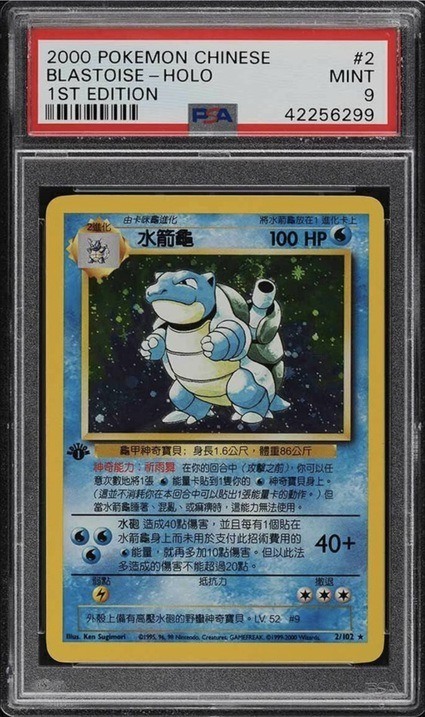
17) 1996 Japanese Pokemon No Rarity
Sold in May, 2021 for $2,326
The Pokemon Trading Card Game officially launched in Japan in October 1996 when Media Factory began distributing its now-legendary trading card game based on the Pokemon series.
The Basic Set cards and their illustrations by artists Ken Sugimori, Mitsuhiro Arita, and Keiji Kinebuchi are now iconic in the card collecting community.
Most Japanese basic set cards will contain a "rarity symbol" in the lower-right corner of the card that varies based on the card type.
Holographic cards in the set feature a star symbol, so if you find a Blastoise card without the rarity symbol, then you know you're looking at the more rare, first-print "no rarity" Blastoise.
The "no rarity" Blastoises are much more difficult to find as PSA has graded just 135 of them compared to 1,548 regular base set Blastoises.
Forty of the "no rarity" Blastoises have received a PSA 8 grade, like this one that sold for $2,326 recently, while just four have received a PSA 10 grade.
The price on a PSA 10 would be far higher.
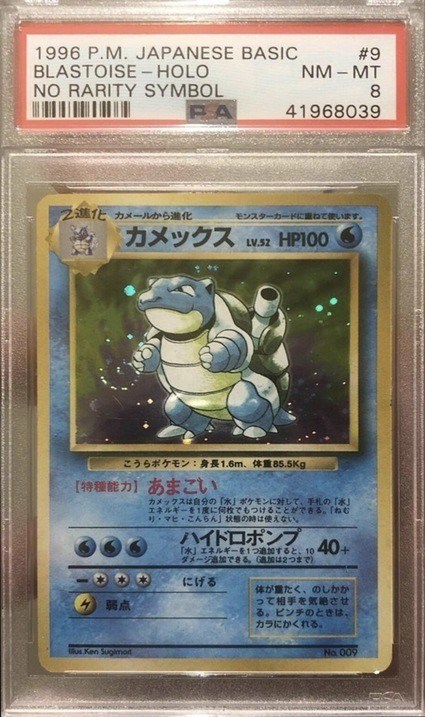
16) 1999 Pokemon French First Edition Tortank
Sold in August, 2021 for $2,425
After Le départ, the first episode of the Pokemon anime appeared on French television in September 1999, and the franchise took off throughout France.
And in November 1999, the Pokemon Trading Card Game officially launched throughout the country.
The French First Edition Blastoise is easily recognizable by the French translation of the game mechanics but most obviously by the name "Tortank," or the French name for Blastoise, at the top of the card.
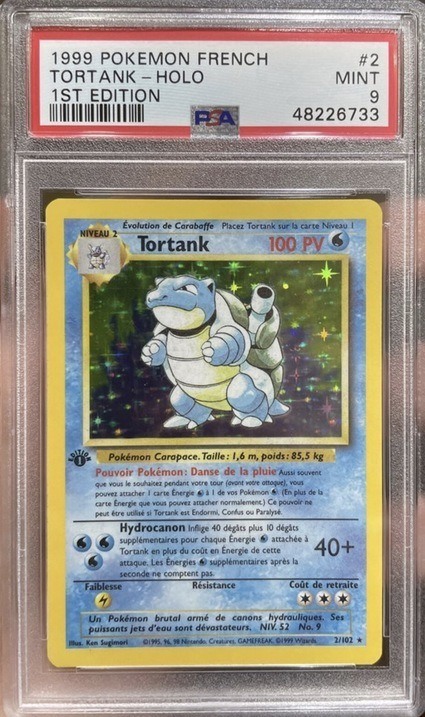
15) 1996 Japanese Pokemon Basic
Sold in January, 2021 for $2,500
If you look in the lower-right corner of the standard 1996 Japanese Basic Blastoise card, you can easily see the star symbol that all holographic cards carried.
Compared to just four examples of the "no rarity" having received a PSA 10 grade, just over 300 examples of the standard basic Blastoise have earned the PSA 10 grade.
That should give you an idea about how much more difficult it is to find a "no rarity" variation in top grade.
Still, collectors will pay thousands of dollars for a standard high-grade basic Blastoise.
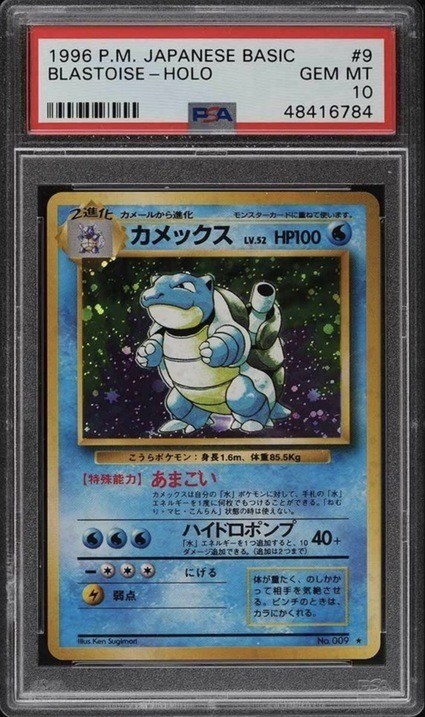
14) 1999 Pokemon Spanish First Edition
Sold in February, 2021 for $2,608
In 1999, the Pokemon anime and video games began appearing in Spain, Chile, Mexico, and other parts of Latin America.
The Spanish version of the card game soon followed, offering native Spanish speakers throughout Europe and Latin America a much more enjoyable way to play the game.
You can see the Spanish translation throughout this card, but the Spanish version does leave the name "Blastoise" as-is.
To verify the card is indeed a First Edition, look to the lower-left of the character box, and you will find the "Edicion 1" symbol.
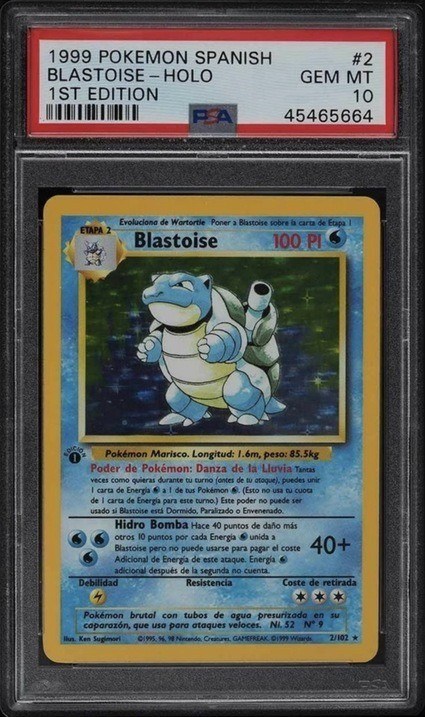
13) 2002 Legendary Collection Reverse
Sold in July, 2021 for $3,000
Legendary Collection made its debut on May 2002 and featured a 110-card checklist composed of reprints from the Base Set, Jungle, Fossil and Team Rocket expansions.
Cards came in one of two theme decks: Lava or Turmoil.
While Charizard was an exclusive in the Lava deck, both the Dark Raichu and Dark Blastoise were exclusive to the Turmoil deck.
Dark Blastoise first appeared in the Team Rocket expansion as both a holofoil and non-holofoil card.
In the 2002 Legendary Collection set, however, Dark Blastoise appeared on a "reverse holofoil" design in which everything but the character artwork features the holofoil element.
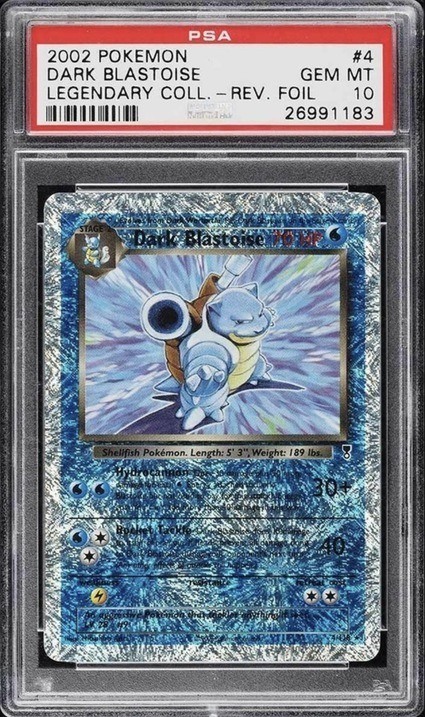
12) 2004 EX FireRed & LeafGreen
Sold in December, 2020 for $3,050
Released on August 30, 2004, the EX FireRed & LeafGreen made its mark as the sixth main expansion of the EX Series Pokemon cards.
The checklist featured 116 cards based on Generation I Pokemon and the Kanto region of the Pokemon world and the Blastoise ex #104 was one of eight rare holos in the set.
Enthusiasts of this set were encouraged to: "Get ready for an epic adventure. Collect Pokémon from the Kanto region and send them head-to-head against Pokémon from Hoenn. Capture them. Train them. And, move one step closer to becoming a Master Trainer!"
Along with that exciting marketing message, the artwork on the card was fantastic, and the Blastoise ex card was no exception.
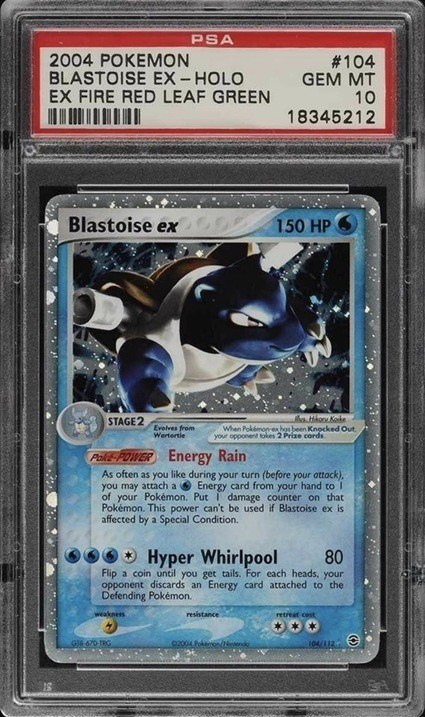
11) 2000 Pokemon Base Set 2
Sold in February, 2021 for $3,750
The fourth main expansion of the Pokemon Trading Card Game, or Base Set 2, began hitting store shelves in early 2000 and featured a combination of reprints from both the Base Set and Jungle expansions.
Though it was a bit unpopular at the time, high-grade Base Set 2 cards have slowly and steadily picked up in value recently.
Since they were reprints, they have a nearly identical look and feel to them as the Base Set cards but are easily identified by the Base Set 2 logo of a 2 with a Pokeball to the lower-right of the character art box.
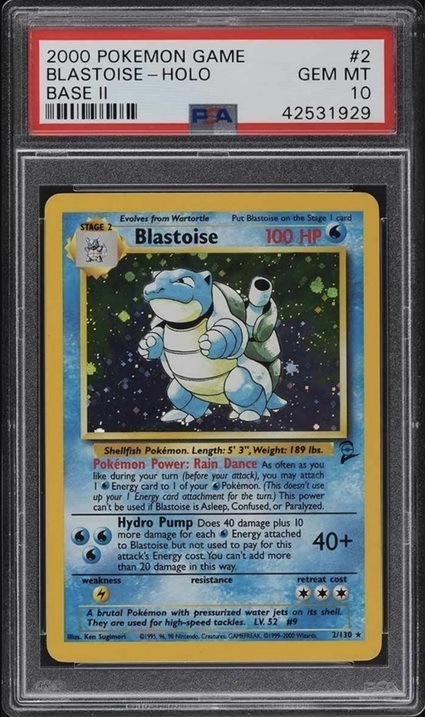
10) 2000 Pokemon Rocket Dark Blastoise
Sold in February, 2021 for $4,075
Team Rocket, the fifth main expansion of the Pokemon Trading Card Game, debuted in English on April 24, 2000.
Featuring Generation 1 and Team Rocket characters in its 83-card checklist, this set may not be as popular as the base set, but it's continued to hold its own quite impressively over the years.
The set is also infamous for its introduction of Dark Pokemon with lower HPs but increased attack damage versus their normal Pokemon selves.
You can find this card in both an Unlimited Edition and First Edition, with the latter carrying a hefty premium in price in top condition.
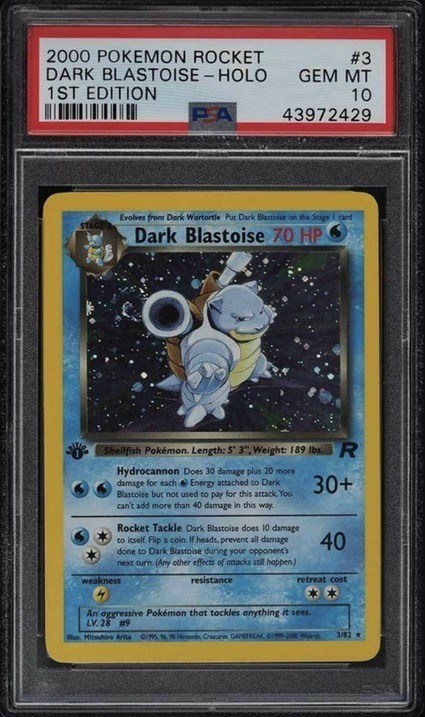
9) 1995 Japanese Topsun Blue Back
Sold in February, 2021 for $4,305
The 1995 Japanese Topsun cards are some of the most interesting early Pokemon cards and were distributed in packs of apple-flavored gum.
Collectors could find these cards in one of three versions: blue-back, green-back, and prism holofoil.
While 150 different characters appeared on the blue-back and green-back cards, only sixteen (including Blastoise) received a prism holofoil version.
The prism Blastoise is the most desirable of the three, but the blue-back and green-back are expensive in top condition as well.
PSA has graded nearly the same number of blue-backs (74) as green-backs (73) but has given out just 15 PSA 10 grades to the blue-backs versus 34 for the green-backs.
Given its relative scarcity, the blue-back version carries a premium over its green-back cousin.
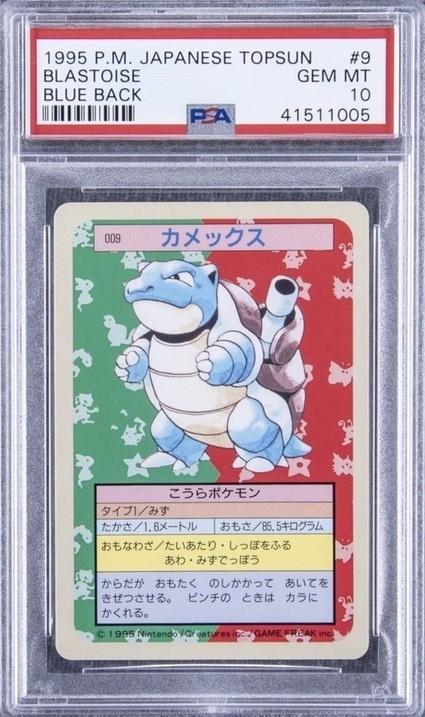
8) 1999 Pokemon German First Edition Turtok
Sold in October, 2020 for $4,750
When RTL II, a German television channel, aired the "Pika - Pikachu" episode for the first time on September 1, 1999, the Pokemon franchise had officially arrived in Germany.
Soon after that, the Red and Blue video games and trading card games followed.
The German market soon fell in love with "Turtok," and those fortunate enough to have held onto a First Edition version of its base set card made a wise decision.
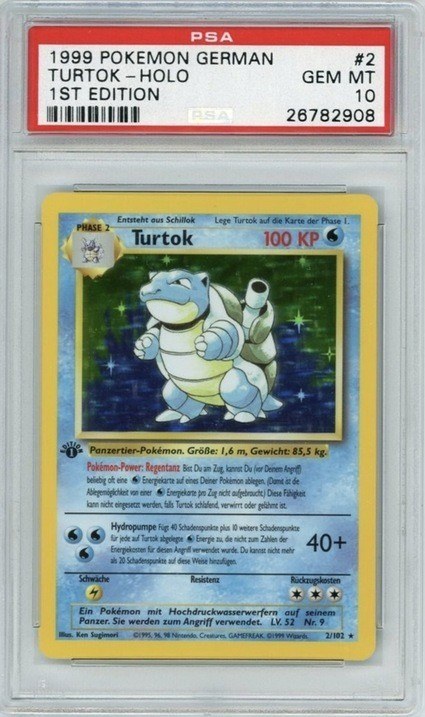
7) 2002 Expedition For Position Only
Estimate $5,000
The Expedition Base Set was part of the e-Card series of Pokemon cards that contained Dot Code technology.
Using the card with the Nintendo e-Reader, players could open a whole new experience by playing a minigame, viewing Pokedex data, and more.
The English version of the set contained 165 cards, seven of which (including Blastoise #36) Wizards of the Coast printed as a test run with the words "For Position Only" printed in white text across the character art box.
The 2002 Expedition "For Position Only" card is one of the rarest Blastoise cards in the hobby, with around a few dozen or so considered to exist.
They don't come up for sale often, so sales history is challenging to find.
That said, the price estimate of $5,000 in a BGS 9.5 or PSA 10 holder is likely low.
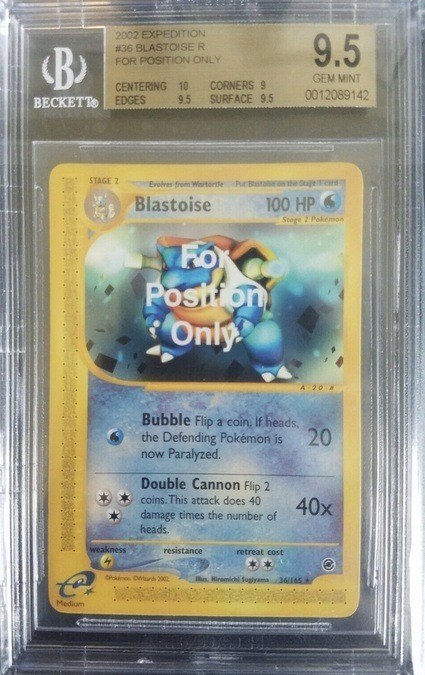
6) 1999 Pokemon Base Set Unlimited
Sold in October, 2020 for $6,700
The Pokemon Base Set kicked off the Pokemon Trading Card Game craze in the United States in 1999, but its various print runs can make a big difference in pricing.
The "Limited" print run appeared in two different forms that collectors and enthusiasts throughout the hobby know as "First Edition" and "Shadowless."
First Edition cards are the most desirable base set cards and contain an "Edition 1" symbol to the lower-left of Blastoise's art box.
The Shadowless print run followed the First Edition, and these cards are identifiable by the absence of both the "Edition 1" symbol and the lack of any shadow around the base and right-hand side of the art box.
Finally, the "Unlimited" print run came about to meet the enormous demand.
Wizards of the Coast made some design changes on the Unlimited cards, namely the inclusion of a shadow around the bottom and right edges of the art box and an emboldened typeface on the HP value.
Because the Unlimited variation is far more common, it is the least expensive of the base set, but that doesn't mean it's necessarily cheap.
First Edition
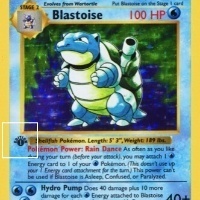
Shadowless
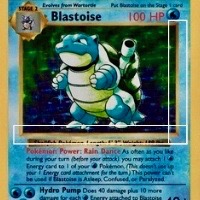
Unlimited
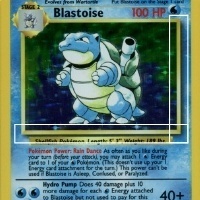
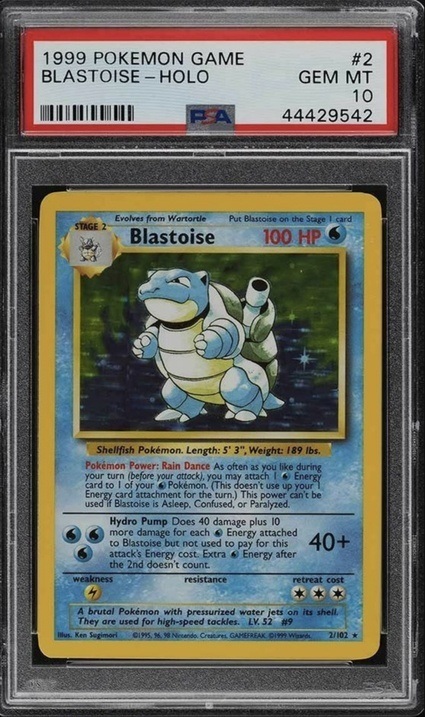
5) 1999 Pokemon Base Set Shadowless
Sold in June, 2020 for $8,100
Of the three versions of the base set cards, the Shadowless sits in the middle on the scale of desirability.
Again, this card lacks the "Edition 1" symbol and shadow around the character art box.
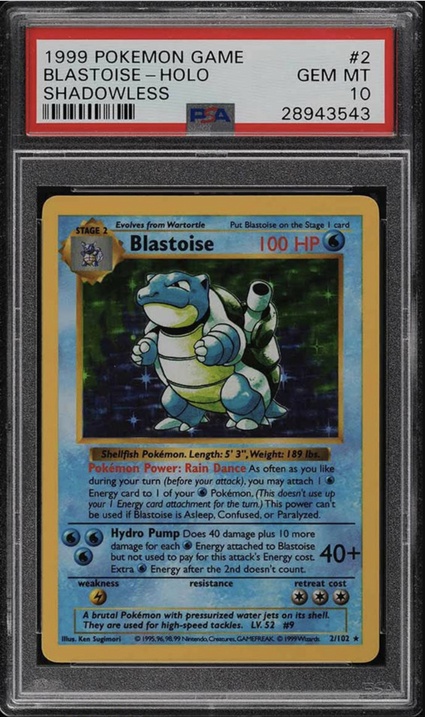
4) 1999 Pokemon Trainer Deck B Blastoise
Sold in March, 2021 for $20,000
As a promotional piece ahead of the official launch of the Pokemon Trading Card Game in North America, some Pokemon League members received a special "Trainer Deck B" or "Misty's Deck," as some call it.
The Trainer Deck B theme deck contained sixty base set cards in all, with the most desirable of them being Blastoise since Charizard is noticeably absent from the checklist.
Though it may look quite similar to a typical base set Blastoise, the Trainer Deck B or "Misty's Deck" Blastoise is different in two ways:
- it is the only non-holographic base set Blastoise
- the back of the card features red borders with "Trainer Deck B" printed on the lower half of the Poke Ball
Standard Deck
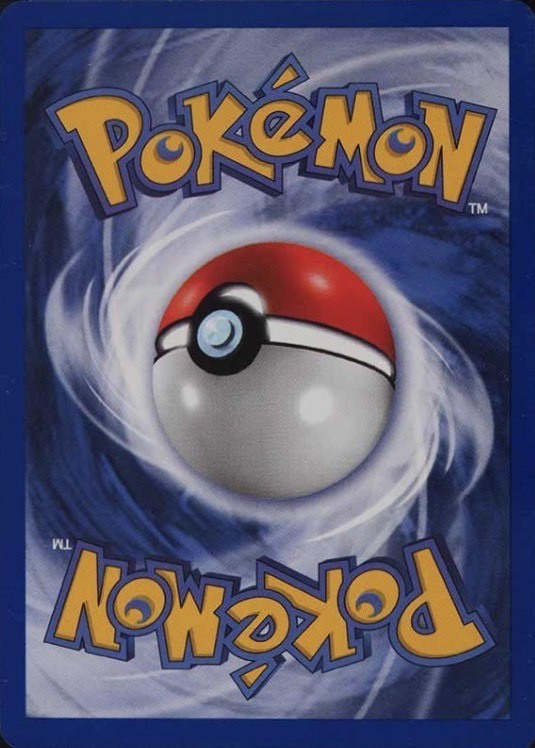
Trainer Deck B
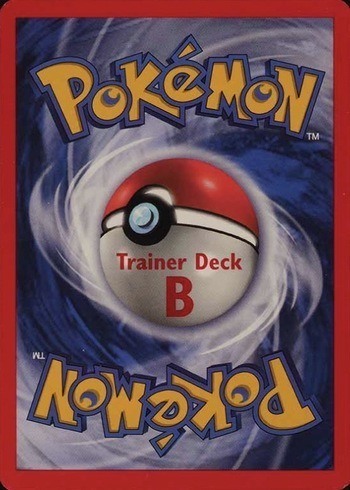
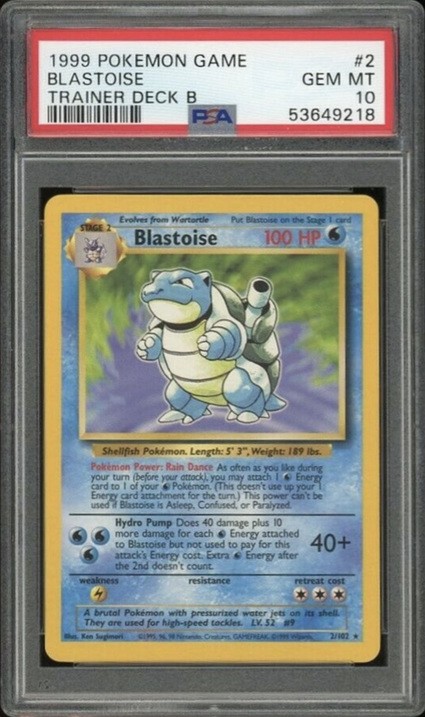
3) 1995 Pokemon Japanese Topsun Holofoil Blastoise
Sold in October, 2020 for $20,100
Though they contain a trademark date of 1995, most collectors believe that Topsun did not distribute them until 1997, given the official Pokemon Trading Card Game didn't debut in Japan until 1996.
Collectors could find these cards in packs of apple-flavored gum in one of three versions: blue-back, green-back, and prism holofoil.
While 150 different characters appeared on the blue-back and green-back cards, only 16 received a prism holofoil version, Blastoise being one of them.
The flashy aesthetic appeal of this card is immediately apparent, and it's also notable that the image of Blastoise is the same that appeared on the cover art of the Pokemon Blue videogame released on the Nintendo Game Boy in Japan in 1996.
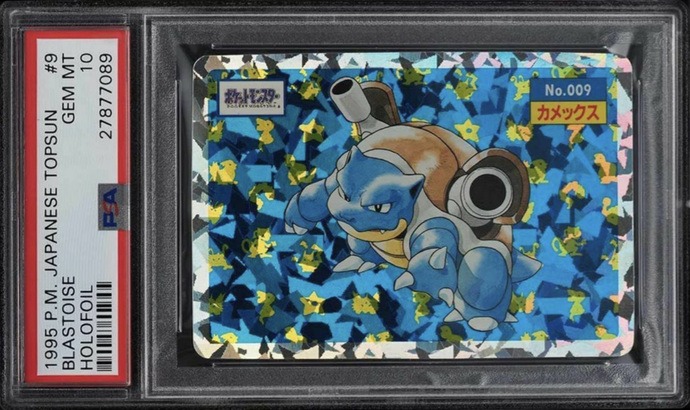
2) 1999 Pokemon First Edition Blastoise
Sold in November, 2020 for $45,100
Whether you are considering First Edition, Shadowless, or Unlimited base set Pokemon cards, the nostalgia for them only seems to grow higher and higher as the years pass.
And that's especially true for First Edition base set cards as the price tags in recent times have exploded to levels previously thought impossible.
Just remember, the easiest way to identify a First Edition Blastoise card is to look for the "Edition 1" stamp just to the lower left of the holographic image and no shadowing effect behind its right and bottom borders.
Out of the 2,070 first edition Blastoise cards submitted to PSA as of this writing, 100 of them have been given the PSA 10 distinction, or roughly 4.8% of them.
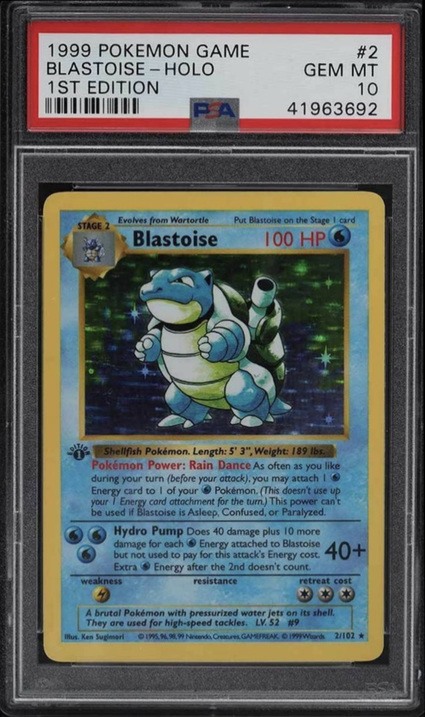
1) 1998 “Backless Blastoise” Commissioned Presentation Galaxy Star Holo
Sold in January, 2021 for $360,000
Collectors and investors were stunned, to say the least, when this extremely rare Blastoise card surfaced for auction in early 2021.
When Wizards of the Coast was initially preparing to launch the English version of its base set in 1999, they used this presentation card as a test run to help get out the word and offer an early look.
The card looks very similar to the base set Blastoise, but with a few key differences, namely the squared corners, a different image of Blastoise, and a reverse side that is entirely blank.
So how rare is this card exactly?
It's believed that WOTC only printed two of them, so collectors and investors went all out during an auction in early 2021 for the chance at owning this one, with the eventual winner paying $360,000 for the honor.
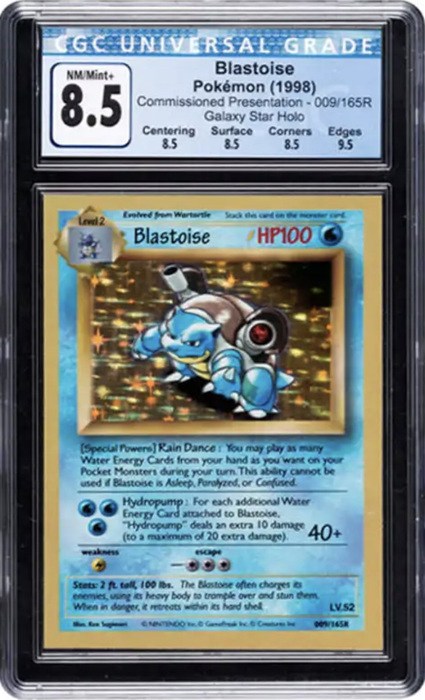
Blastoise Pokémon Cards In Review
Blastoise remains one of the most iconic Pokemon of all time and clearly, card values have continued to soar as the non-sports card collecting world remains strong.
Investors and collectors are more than willing to pay steep price tags to own any one of the cards on this list.
Though Blastoise doesn't fetch the kind of money that Charizard does, these cards should remain strong investments for quite some time given the popularity of the franchise.
